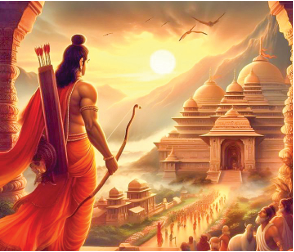“One who is virtuous and wise, just and merciful, is a true human.”
— Lord Rama
Diwali as a celebration of Lord Rama’s arrival spreads a different kind of positivity across the country; a kind of an infectious enthusiasm that sweeps in every corner. Homes adorned with lamps, lanterns, glittering diyas, and rangeen rangolis, bring family and friends together with joy. Children’s eyes sparkle like fooljhadi as they eagerly await the festivities, with the scent of traditional mithayi and savory delicacies wafting through the streets, teasing their taste buds.
This year, Diwali’s luminous aura made my young boy’s heart pound extra fast with exhilaration, for he is representing the character of legendary Rama in his school’s theatrical rendition. However, we all know, fate always has its own plans beyond human mind and heart, and unfortunately, it tried to put a curtain on my little one’s enthusiasm with high fever, and the suspense of dengue, moreover, the torture of blood tests, adding more to lowering his morale.
Still, his zeal for participation rests uncontrolled. After my many attempts of counseling and allures for not going to school with high fever, he didn’t stay back home. Portraying Rama, Maryadapurushottam, the supreme exemplar of humanity’s noblest qualities, has been his cherished dream, a role model of righteousness and ethical wisdom that reverberates deeply within his tender soul. He told early in the morning like a chirpy bird that the mere possibility of being given the role as Ravana had sent shivers down his spine, and his heart has always yearned to embody the virtues of the heroic prince, Rama with a bow and arrows, discarding bad and embracing good.
In the gentle hush of dawn, when he woke up early; his eyes were glistening with eagerness and he confessed his joy to me in becoming Rama. That fleeting jiffy spent with him inspired me to reflect on the weakening link between our youth and the eternal epics and rituals that have shaped our Indian culture, customs and traditions.
When Diwali approaches at our doors, we are in the circle of charismatic and timeless saga of the Ramayana, the arrival of Rama and Sita at home, the air seems to carry moral integrity and righteous conduct in the surroundings, gesturing the youth of the country to cuddle the festivity with an understanding of veiled profound teachings to bring those at the fore and implement in behaviour and life.
As households illuminate their homes with diyas, symbolizing the dispelling of ignorance, they also rekindle the spirit of community, love, and devotion. Youth can channel these celebrations into an awakening that urges them to evident the embodiment of Ram Rajya, nurturing a society where ethical standards are sustained.
In an era where gadgets and evanescent distractions have caught young minds in tight devilish hold, the allure of objectionable content threatens overshadowing the values that Rama’s legend embodies, I feel nostalgic. When the world celebrates Diwali’s triumph of light over darkness, childhood memories of my grandparents’ house flashes in my mind. With in the warmth and affection embedded walls of their house, after all cleaning and dusting used to be over, especially of grandfather’s study, I used to immerse myself in those leisure hours reading my all time favourite sagas of Ramayana and Mahabharata.
But here, I find myself stuck in different landscape where the enchanting glow of smartphones have kept young hearts stay away from the bliss of reading and enjoying the revered pages of our epics. Young hearts and minds, I feel will remain unwatered by the sacred nectar of our heritage, and values if they don’t resound with the fervor of tradition. They need to be connected to lead a revival of dharma in contemporary India, emphasizing justice, equality, and harmony in every action they undertake via learning timeless lessons of our sacred texts such as Ramayana, Mahabharata, and Bhagvad Gita.
The philosophy of dharma is woven complicatedly into the narrative of the Ramayana, signifying duty with the essence of righteousness, urging individuals to uphold moral values in all facets of life. Rama, symbolizing dharma, illustrates generosity, duty and assurance even when facing disheartening choices in his life. His acceptance of exile being obedient towards his father, a sacrifice for familial honor is touchingly eternalized in words that echo through the ages.
The ethical teachings of the Ramayana, though deep-rooted in ancient contexts, hold insightful relevance. This epic offers enduring guidance on managing moral dilemmas, upholding integrity, and sensitivity towards all people promoting equality and balancing personal ambitions with societal responsibilities. Lord Rama’s ability to fulfill his duties as both, a king and a family man teaches us the importance of balancing and fulfilling our professional and family responsibilities. Listing family time at priority, even under work pressures, associating ourselves with the value of dharma, reminding us that domestic roles are just as fundamental as professional ones. His decision to accept exile over the throne in the Ramayana, though he knew it will bring many problems in his life, reveals the importance of long-standing values over instant profits. Similarly, in managing domestic finances, prioritizing long-term stability such as saving for future needs over short-term forbearances is essential.
Rama’s fortitude can call for self-analysis among the youth and motivate. It stimulates an awakening to the importance of prioritizing virtues like loyalty, honesty, and sacrifice, which are crucial to determining a harmonious society, ‘an akhand samaj’, ‘a Ram Rajya’. Rajendra Krishan’s lines- “Ramchandra keh gye Siya se, Aisa kalyug aayega, Hans chugega dana dunka Kauwa moti khayega..” should be utterly discarded and proven wrong but that can happen only when youth inculcates good values and contributes in the establishment of a better Indian community.
The virtues of Rama, his steadfastness as a son, his commitment as a husband, and his integrity as a king serve as a paradigm for the youth. His interactions embody ideals that, when nurtured, can serve as a guide through the challenges of modernity. As Rama governing the kingdom brings prosperity and peace, so too can enlightened youth bring about a renaissance in India, building communities rooted in understanding and reconciliation.
We should not forget the importance of honesty and devotion that Sita and Hanuman represent. These relationships condense solidarity, loyalty and the spirit of sacrifice, signifying how love and affection for family and friends strengthens the grounds of ethical society.
Educators and parents should make the impressionable hearts of children and youth be touched by Rama’s bravery, Hanuman’s devotion and Sita’s resilience. They should be guided with the Ramayana’s eternal and ethical wisdom throughout their life’s complexities, illuminating their path to a brighter future.
Be the architect of a brighter future. Learn to foster empathy, compassion, and selflessness. Follow Rama’s benevolence, Sita’s spirit and Laxman’s loyalty. Resolve conflicts in relationships. Have ethical wisdom for the right action. Understand that true victory lies not in material wealth but in the conquest of one’s own ego and desires.
In this passing phase, my young Rama’s enthusiasm rekindles hope; hope that the next generation will cherish the values that have defined our civilization for centuries. I hope his performance inspires a resurgence of interest in our epics, nurturing a new era of youth who embody the timeless spirit of Rama.
As India has embarked on a new era with the establishment of the Ram Mandir in Ayodhya, let us rekindle the dream of Ram Rajya, a realm of justice, equality, and harmony. By embracing Ramayana’s ethical principles, our youth can create a world where the lines from Taittiriya Upanishad- “Satyam Vada, Dharmam Chara” (Speak the truth, follow dharma) become the guiding mantra for a shinning India.
Dr. Shalini Yadav is a distinguished scholar, writer, columnist and journalist from Jaipur, Rajasthan.




